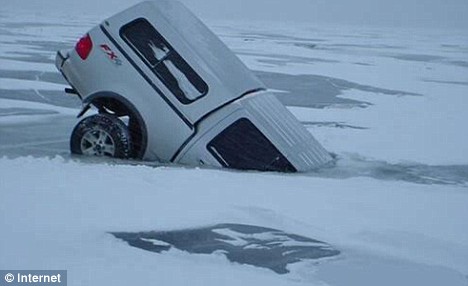
by Flagship Staff | Feb 6, 2017 | Blog
This is the time of year when ponds and lakes are frozen. Soon you’ll be getting ready to get your vehicle out on the open, frozen water to enjoy the great outdoors. But what would you do if the unthinkable – but sinkable – happens and your vehicle breaks through the ice?
How is your car covered if it breaks through the ice?
As long as you have comprehensive (other than collision) coverage on the auto, there’s actual cash value coverage for the auto. West Bend will also provide coverage for the retrieval cost of the vehicle’s extraction from the body of water.
What happens if your car does not have comprehensive coverage (other than collision)?
Your insurance may provide coverage for the retrieval costs of the vehicle’s extraction from the body of water as property damage under your auto liability coverage.
There’s no coverage for the cost of the vehicle itself. Any fines assessed to you for the car falling through the ice would also be paid by you.
What happens if your ATV, snowmobile, or other recreational vehicle breaks though the ice?
If your recreational vehicle carries physical damage coverage, it would be covered if it sinks. The deductible would apply. Your insurance company may also provide coverage for the retrieval costs of the recreational vehicle’s extraction from the body of water.
What happens if your ATV, snowmobile, or other recreational vehicle doesn’t have comprehensive coverage (other than collision)?
If you don’t have physical damage coverage on your recreational vehicle, your insurance may provide up to $1,000 of coverage for the recreational vehicle itself and the retrieval costs of the recreational vehicle’s extraction from the body of water.
Pollution and any other fines assessed to you for the recreational vehicle falling through the ice would be paid by you.
Before heading out on the ice
To keep you and your vehicle afloat, be sure to take the necessary safety precautions. First, check with your local bait shop or lakeside resort about ice conditions, then check the ice thickness when you get there.
Ice thickness guidelines:
2″ or less – STAY OFF!
4″ – Ice fishing or other activities on foot
5″ – Snowmobile or ATV
8″ – 12″ – Car or small pickup
12″ – 15″ – Medium truck
Remember, temperature, snow cover, currents, and springs all affect ice safety. Ice is rarely the same thickness over a single body of water; it can be two feet thick in one place and one inch thick a few yards away. Check the ice at least every 150 feet. Park cars, pickups, and sport utility vehicles at least 50 feet apart and move them every two hours to prevent sinking.
With common sense and precaution, you’ll keep your vehicles above water and enjoy a safe season outdoors!
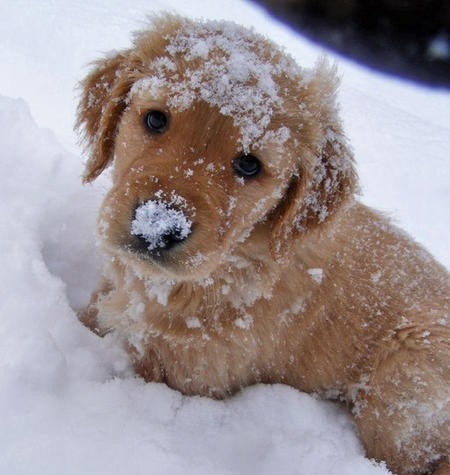
by Flagship Staff | Feb 1, 2017 | Blog
Do you have a new furry member in your family? Is this your first winter with them? If so, winter weather can be challenging for both of you.
Pets are a great addition to the family. They bring laughter and companionship to our lives. In return, most of us want to provide the best care we can to our beloved pets, and during the winter months, they may need a bit more care.
Here are some tips that can help you if you live in a Winter Wonderland.
1. Don’t zap your cat. A cat’s physiology, and its behavior, are different than dogs. Many dogs like to snuggle with you and enjoy it when you pet their heads or rub their bellies. On the other hand, while your cat may like to hang out you, he may not like being petted. The reason is static electricity. If you stroke a cat, from head to tail, this may aggravate him because static electricity builds up in his body. When we run the furnace in the winter, the static electricity in our home intensifies and can make your cat uncomfortable. Simply walking around the house can cause a zap if you touch your cat. If your cat likes to play on your furniture, he could be zapped.
To help control the zap factor in your home, run a humidifier. Keeping the humidity in your home between 20 and 50 percent can create a more comfortable environment.
If your cat tolerates water, spray a mister on his entire body to help eliminate static electricity.
Keep in mind that there are several benefits to installing a humidifier in your home even if you don’t have pets.
2. A good pair of boots. Depending on your level of activity during the winter, a good pair of boots can prevent cold feet and frostbite. If this is your first winter with your pet, don’t forget about their paws. Our pet’s paws can take a beating during the winter months. Check their paws frequently to make sure the paw pads aren’t cracked or bleeding.
3. Clean their boots. After a refreshing winter walk, it’s important to clean off their paws as soon as you return home. They may have picked up toxic chemicals or have sidewalk salt stuck between their toes. This is also a good time to check for injury or trauma to their paws. If you want to protect their paws or avoid cleaning them, booties are an option if they’ll wear them. Don’t forget to scrub their bellies as well!
4. Eliminate access to the garage. Our vehicles make a mess on the garage floor in the winter with slush and toxins from melting snow. If you have an older car, it may contain antifreeze that tastes sweet to our pets. Antifreeze, which is crucial to keeping our cars running, is extremely dangerous. If a small amount is ingested it can be fatal because it will lead to kidney failure.
If your pet has wandered into your garage and afterward, shows these symptoms, seek medical attention immediately. Medicine is available but must be given quickly after ingestion.
Symptoms of antifreeze poisoning
Staggering;
Lethargy;
Excessive drinking; and
Seizures.
Today, major marketers of antifreezes have changed the formula from a sweet taste to a bitter taste. Please be aware, however, that this doesn’t make antifreeze safer. It’s an attempt to keep them from ingesting large quantities.
If you notice an antifreeze leak in your garage or if you spill it, clean it up immediately. Using kitty litter is a safe way to soak it up. Use large amounts of water to rinse your floor.
5. Shovel your yard. While shoveling snow isn’t fun, it’s important to clear a spot in your yard for your pet. Some dogs hate going out in the snow and cold. An area free of snow and salt can make life easier for both of you. Also, consider accompanying them outside if it’s very cold. Using familiar verbal commands may keep them focused on what they’re supposed to do (i.e. “go potty” or “get busy”). A delicious treat afterward will help reward and reinforce their good behavior.
6. Cold cars are dangerous too. During the summer months, we hear news reports about the danger of leaving your child or pet in the car unattended. Winter can be just as dangerous. If you have to leave them unattended, it’s best to leave them at home.
7. Too cold for you? If you have multiple pets, each one may experience the cold weather differently. Pay attention. If one dog loves long walks and playing in the snow, let her at it. If your other dog is miserable, come up with a different routine for him. In the end, if it’s too cold for you, it’s probably too cold for them.
8. Wear reflective clothing. If you enjoy walking your dog before sunrise or after sunset, make sure both of you wear reflective clothing. Motorists don’t expect to see people out and about during the winter months. Even if you live in a well-lit neighborhood, it still may be difficult for motorists to see you.
9. Keep them on their leashes. City ordinances usually require your dog to be on leash when strolling through your neighborhood. If you normally give your pet some freedom and remove the leash, winter is not the time to do it. Snowfall can make it difficult for pets to find their way home if they get lost.
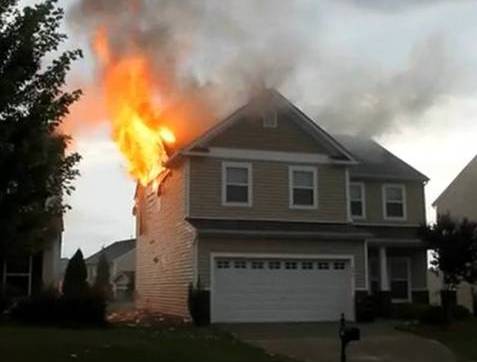
by Flagship Staff | Jan 26, 2017 | Blog
If you’re building a new home, remodeling your existing home, or you recently built a new deck, you may be staining the new woodwork yourself. While it saves money, it can be a bit scary and dangerous.
Stain is permanent! It will stain your clothes, fingers, and anything else it meets. So if you’re trying a DIY staining project, wear protective eyewear, rubber gloves, and old clothing. Oil-based stains also have fumes, so it’s important to work in a properly-ventilated area.
The staining project turns dangerous if you don’t properly store or dispose of the used rags.
Oil-based stains are very common with woodworking projects. Linseed based stains can be found on every hardware store’s shelf. They’re used for staining furniture, floors, decks, and woodwork in your home. However, if they’re not stored or disposed of properly, they can auto-ignite and start a fire in your home. Unfortunately, people have lost their homes and possessions because of this dangerous situation.
So how can a pile of rags sitting on your garage floor start a fire? As oily rags begin to dry, heat is produced. If they’re thrown into a pile, oxygen is trapped underneath. The combination of heat, oxygen and the cloth can lead to spontaneous combustion, which results in a fire that could destroy your home.
Here are some tips for storing and disposing of oily rags.
1.Never store rags in a pile. Used rags should be spread out in a safe flat area to dry. If you lay them out on your garage floor or driveway, weight them down so the wind doesn’t blow them away. Once they’re dry, check with your city or municipality for disposal instructions.
2.Store the rags in an airtight, non-combustible metal container. If you plan to use your rags later, this step is critical. The metal container should be filled with a solution of water and an oil breakdown detergent.
3.Follow the manufacturer’s recommendations. Since manufacturers use different oils in their products, it’s important to follow their warnings and disposal instructions. They may differ from manufacturer to manufacturer.
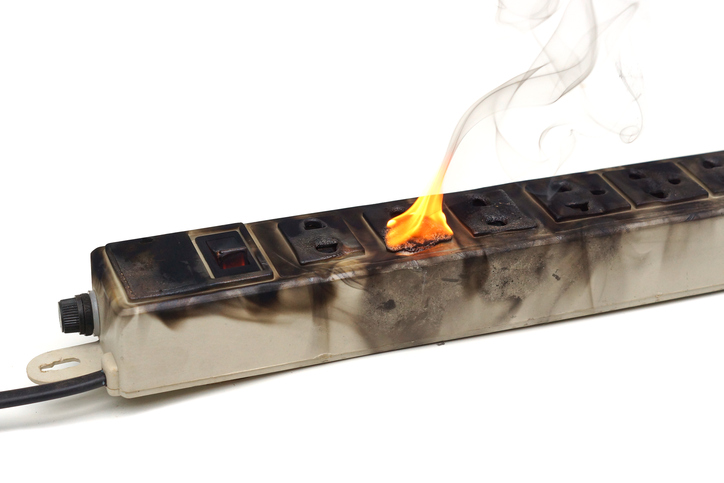
by Flagship Staff | Jan 12, 2017 | Blog
When people think of homeowners’ insurance claims, they often associate them with major disasters such as hurricanes, tornadoes or wildfires. In these situations, there’s not much that policyholders can do to avoid disaster. Fortunately, many homeowner losses are entirely preventable. In 2014, 5.3 percent of insured homes had a claim, according to the Insurance Information Institute and ISO data. Property damage, including theft, accounted for 97.3 percent of those claims.
Insurance agents should remind clients that homeowners’ insurance may not pay if a claim could have been avoided with proper maintenance. It pays to take care of your home
Here are 15 examples of preventable home insurance claims, followed by tips for reducing the liklihood a claim will need to be filed:
1. Washing machine mishaps
Hub International recommends that you avoid loose or damaged washing machine hoses by replacing them at least every three years, and inspect frequently for irregularities. If possible, situate your machine in an area where you will detect water problems right away.
2. Bath tub/shower grout and edge leaks
Over time, shower and tub grout or caulking can decay, or cracks can develop which allow water into the wall or floors and starts to rot the wood. Check and maintain seals.
Water that flows into your bath or shower needs to stay there, or travel down the drain. Close doors and curtains. Wipe up spills on surrounding areas quickly.
Frequently inspect and repair seals, calling in a professional when in doubt. Some contractors recommend resealing every year.
3. Toilet issues
Toilet wobbling? It might not be properly installed or the toilet seal may be worn out. Check for water around the base of the toilet.
Experiencing a leak? Call a qualified expert immediately. Consistent attention is key to sparing yourself and your family thousands of dollars in damages.
4. Refrigerator water supply leaks
The water and plastic lines that extend from your fridge can cause extensive kitchen damage in no time. If you’re comfortable or handy, check the lines regularly for kinks. If uncertain, contact an experienced professional.
5. Roof leaks and collapses
Basic roof maintenance, such as gutter cleaning and shingle replacement, is key to a longer roof life. Check overhanging tree branches and trim them away from the roof to avoid rubbing in wind. Check for loose or missing shingles.
During the winter storm season, it’s important to monitor weather conditions and roof conditions to help protect against roof collapse from snow and ice accumulation.
Be aware of any warning signs that the building structure may be under significant stress and perhaps in danger of collapse. Signs may include:
•Deflection or cracking of structural members.
•Cracks that have recently developed in interior and exterior walls and ceilings.
•Cracked or broken windows.
•Sprinkler heads that are pushed down below dropped ceiling tiles.
•Unusual creaking or popping sounds.
•Doors or windows that bind or do not open and close properly due to racked frames.
If there are signs of deflection or damage to the building’s structure, a qualified structural engineer should be contacted for an immediate inspection.
6. Chimney and fireplace fires
Cold weather regularly brings fires caused by dirty or plugged chimneys. Implement all fire safety best practices and maintain a regular chimney-cleaning schedule.
Installation of a spark arrestor on chimneys will protect cedar shake roofs. Ashes should be disposed of in a metal container, never paper or plastic.
7. Hot water heater leaks
Leaking water heaters result in countless insurance claims each year. If a small leak goes unnoticed — occurring while you are on vacation, for example — the damage can quickly escalate into a major claim.
Regularly inspect the water heater and the pipes around the unit for any signs of leakage, moisture, mold, mineral buildup and corrosion.
It’s a good idea to flush the water heater tank twice a year to eliminate sediment buildup. Putting in an inexpensive drip pan below the water heater that drains to the outside of the property can help prevent thousands of dollars in water damage in many cases.
Age is also a big factor. Many water heater manufacturers estimate the lifespan of these appliances to be 8 to 12 years, so replacing a unit when it is nearing this age can be good insurance policy against unwanted damage.
If your water heater is more than five years old, a qualified technician should inspect it at least every year.
8. Electrical fires
Here are some specific tips from SafeElectricity.org to avoid electrical fires in your home:
•Check for loose-fitting plugs in electrical outlets, which can be a fire hazard. Replace missing or broken wall plates so wiring and components are not exposed.
•Avoid overloading outlets with adapters and too many appliance plugs.
•Make sure cords are not frayed or cracked, placed under carpets or rugs, or placed in high traffic areas. Don’t nail or staple cords to walls, floors or other objects.
•Use extension cords on a temporary basis only. They are not intended as permanent household wiring.
•If an appliance repeatedly blows a fuse, trips a circuit breaker or has given you an electrical shock, immediately unplug it and have it repaired or replaced.
•Wiring defects are a major cause of residential blazes. Check periodically for loose wall receptacles, loose wires, or loose lighting fixtures. Listen for popping or sizzling sounds behind walls. Immediately shut off, then professionally replace light switches that are hot to the touch and lights that spark and flicker.
9. Cooking or candle fires
Second only to water damage, fire devastation is a common source of homeowners’ insurance claims. An open flame, or gas, is often necessary for preparing food, warming and illuminating the home.
Cooking equipment is the leading cause of home fire injuries, followed by heating equipment, according to the National Fire Protection Association.
During 2009-2013, candles caused 3 percent of home fires, 3 percent of home fire deaths, 6 percent of home fire injuries, and 5 percent of direct property damage from home fires, the association reports.
All fires should be monitored. Unwatched, a fire can spread rapidly and become a tragedy.
10. Garage door opener theft
If your vehicle is not in the closed garage, don’t leave the door opener behind in your vehicle. A garage door opener left in a car that is sitting in the driveway or on the street, gives a thief easy access to the house
11. Furnace issues
Make sure your furnace is in good working condition. Have it inspected regularly, and leave repairs to professionals. When appliances in the home wear out, homeowners’ insurance does not pay.
Homeowners’ insurance pays when pipes freeze, for example. If this happens to a furnace, the homeowner has a valid claim. Electrical surges, a covered peril, damage wiring which could require the replacement of a furnace unit. Another covered peril is the sudden cracking or breakup of hot water pipes, which could lead to a new furnace.
12. Theft and vandalism
Theft and vandalism are less common types of homeowners’ insurance claims, but they can be difficult types of losses to recover from. Even after a home is restored, the fear caused by a break-in can linger.
If you live in a high crime area, here are steps you can take to minimize your chance of becoming a victim:
•Install a security system or outdoor video cameras.
•Get a dog to help protect your property.
•Increase the amount of lights around your property to deter thieves.
•Always be sure to lock your doors when leaving.
13. Dishwasher leaks
Every three months, check all hoses for signs of wear and tear. A cracking or leaking hose can lead to serious water damage to flooring and walls around the appliance, so replace hoses accordingly.
Clean your dishwasher by running it with two cups of vinegar in the bottom. Stop the dishwasher mid-cycle and let it sit for 20 minutes; then restart and let it finish the cycle. This will prevent buildup and clogs which can cause leakage.
14. Dog-related injuries and bites
Millions of people are bitten by dogs each year, which results in a lot of costly homeowners’ insurance claims. Man’s best friend can be a big liability if he bites someone on your property. If you have a dog, consider increasing your personal liability coverage.
Even normally docile dogs may bite when they’re frightened or when defending their puppies, owners or food. The best way to protect yourself from liability is to prevent your dog from biting anyone in the first place.
15. Slip and fall accidents
If someone slips and falls while on your property, you may be liable. Keep steps and walkways in good repair and free from snow, ice and objects that can cause trips, such as debris, toys and tools.
See the Insurance Information Institute’s “Which disasters are covered by homeowners’ insurance” for a handy outline of perils covered under standard homeowners’ policies.
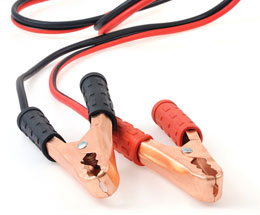
by Flagship Staff | Jan 5, 2017 | Blog
Have you ever jumped into your car, turned the key, and nothing happened? If so, did thoughts like this start racing through your head?
I wonder what’s wrong?
What am I going to do now?
Who can I call?
I hope this isn’t going to be expensive. A dead battery can occur any time, while dead car batteries aren’t just a winter phenomenon, as the temperatures plummet, they can become dangerous at this time of year.
A car battery can last an average of five to seven years if the vehicle is driven regularly. A car that’s kept in storage and not driven for an extended period may need a new battery sooner.
Before a car battery goes completely dead and leaves you stranded, it does give some warning signs. These include:
1. Slow engine crank. A worn-out battery will turn over your car at a slower rate. If your car doesn’t sound right or it takes longer to start, this could be a telltale sign.
2. Warning lights. If battery power is weak, a warning light may appear on your dashboard. In newer cars, this may show as a battery symbol. If this light goes on while you’re driving, don’t turn off your car! If your car doesn’t have a warning light but it’s hard to get it started, keep the car running until you get to your final destination.
3. Crusty connections. Today’s batteries are mostly maintenance free; however, corrosion around the battery posts may indicate a leaking battery. If you notice a lot of corrosion, clean off the posts. Corroded posts can lead to difficulty starting your car.
4. The car is misbehaving. Features in your car may be acting up. For example, your power windows may not open and close efficiently. In addition, your radio may not work correctly.
5. Oil change. When you get your oil changed, some garages will run a complementary battery test. If the mechanic tells you your battery is underperforming and it’s five to seven years old, you may want to have a new one installed.
If you’re left stranded and need a jump-start, here are the appropriate steps to get you back on the road.
1. Take a deep breath. I’ve been in this position before. Once help arrives, there’s a lot of commotion. Always think before you act. If you’re on the side of the road, pay attention to your surroundings. Before exiting your car, make sure it’s safe. If you’re in a parking lot, pay attention to swinging doors and other cars around you.
2. Position the vehicles appropriately. Once help arrives, position the vehicle with the dead battery and the running vehicle so they’re facing each other. If you’re in a parking lot, this may be difficult so get them as close together as possible. Automatic transmission cars should be placed in park and manual transmission cars should be put in neutral. For extra safety, be sure to use the parking brakes in both cars.
3. Turn off the running car. Once the cars are positioned appropriately, turn off the radio, headlights, interior lights, etc. Once this has been done, turn the car off.
4. Identify the battery terminals. The positive has a red indicator or a plus (+) sign. The negative terminal has a black indicator or a negative (-) sign.
5. Identify the jumper cables. The red clamp is positive and the black clamp is negative. A stripe on the cable may also indicate the positive cable.
6. Attach the jumper cables. It’s important to attach the jumper cables in this order.
Attach the positive cable (red) to the positive terminal on the dead battery.
Attach the positive cable (red) to the positive terminal on the functioning battery.
Attach the negative cable (black) to the negative terminal on the functioning battery. Please note the cables are now live! Be careful in handling the remaining negative cable.
Attach the negative cable (black) to a non-painted piece of metal or a bolt on the car with the dead battery. Make sure the cable is clear from moving parts.
7. Ladies and gentleman start your engines. Start the car with the functioning battery and allow it to run for one to two minutes. Next, try starting the car with the dead battery. The engine of the good car can be idled at 3,000 rpms to help transfer the energy through the jumper cables.
8. Disconnect the jumper cables. Now that the car with dead battery is running, it’s time to disconnect the jumper cables.
Start by disconnecting the black or negative cable on the previously dead battery.
Disconnect the black or negative cable on the functioning battery.
Disconnect the red or positive cable on the functioning battery.
Disconnect the red or positive cable on the previously dead battery.
If the car with the dead battery didn’t start, try:
Re-connecting the cables following the steps in #6.
Allow the functioning car to run five to ten minutes with the jumper cables attached to the dead car.
Consider calling a tow truck.





